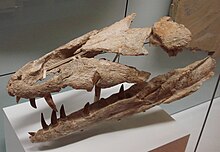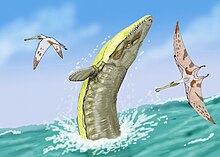Aggiosaurus is an extinct genus of geosaurine metriorhynchid crocodyliform known from the Late Jurassic of Nice, southeastern France. It contains a single species, Aggiosaurus nicaeensis, which was named by H. Ambayrac in 1913.

Machimosaurus is an extinct genus of machimosaurid crocodyliform from the Late Jurassic and Early Cretaceous. The type species, Machimosaurus hugii, was found in Switzerland. Other fossils have been found in England, France, Germany, Portugal, Switzerland and Tunisia. Machimosaurus rex is the largest named teleosauroid and thalattosuchian, with an estimated length of up to 7.15 m (23.5 ft). Machimosaurus is the largest known crocodyliform of the Jurassic.

Metriorhynchus is an extinct genus of marine crocodyliform that lived in the oceans during the Late Jurassic. The type species, M. brevirostris was named in 1829 as a species of Steneosaurus before being named as a separate genus by the German palaeontologist Christian von Meyer in 1832. The name Metriorhynchus means "Moderate snout", and is derived from the Greek Metrio- ("moderate") and -rhynchos ("snout").

Metriorhynchidae is an extinct family of specialized, aquatic metriorhynchoid crocodyliforms from the Middle Jurassic to the Early Cretaceous period of Europe, North America and South America. The name Metriorhynchidae was coined by the Austrian zoologist Leopold Fitzinger in 1843. The group contains two subfamilies, the Metriorhynchinae and the Geosaurinae. They represent the most marine adapted of all archosaurs.

Enaliosuchus is a dubious genus of extinct marine crocodyliform within the family Metriorhynchidae that lived during the Valanginian stage of the Early Cretaceous. It is known from fossil remains found in France and Germany and it was first described in 1883,. The name Enaliosuchus means "Marine crocodile", and is derived from the Greek Enalios- ("marine") and -suchos ("crocodile"). Two species are known: the type species E. macrospondylus, described in 1883, and the second species E. schroederi, described in 1936, which was likely the same animal as E. macrospondylus.

Geosaurus is an extinct genus of marine crocodyliform within the family Metriorhynchidae, that lived during the Late Jurassic and the Early Cretaceous. Geosaurus was a carnivore that spent much, if not all, its life out at sea. No Geosaurus eggs or nests have been discovered, so little is known of the reptile's lifecycle, unlike other large marine reptiles of the Mesozoic, such as plesiosaurs or ichthyosaurs which are known to give birth to live young out at sea. Where Geosaurus mated, whether on land or at sea, is currently unknown. The name Geosaurus means "Mother of Giants lizard", and is derived from the Greek Ge- and σαῦρος -sauros ("lizard"). The name Geosaurus was established by the French naturalist Georges Cuvier in 1824.

Teleidosaurus is an extinct genus of carnivorous metriorhynchoid crocodyliform from Middle Jurassic deposits of Normandy, France. The name Teleidosaurus means "Complete lizard", and is derived from the Greek Teleidos- ("complete") and σαῦρος -sauros ("lizard").
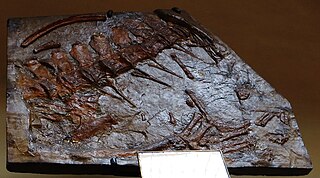
Neustosaurus is a genus of marine crocodyliform from the Early Cretaceous. Neustosaurus was a carnivore that spent much, if not all, its life out at sea. No Neustosaurus eggs or nest have been discovered, so little is known of the reptile's lifecycle, unlike other large marine reptiles of the Mesozoic, such as plesiosaurs or ichthyosaurs which are known to give birth to live young out at sea. Where Neustosaurus mated, whether on land or at sea, is currently unknown. The name Neustosaurus means "Swimming lizard", and is derived from the Greek Neustos- ("swimming") and σαῦρος -sauros ("lizard").
Teleosaurus is an extinct genus of teleosaurid crocodyliform found in the Middle Jurassic Calcaire de Caen Formation of France. It was approximately 3 metres (10 ft) in length. The holotype is MNHN AC 8746, a quarter of a skull and other associated postcranial remains, while other fragmentary specimens are known. The type species is T. cadomensis, but a second species, T. geoffroyi may also exist. It was previously considered a wastebasket taxon, with many other remains assigned to the genus.
Purranisaurus is an extinct genus of marine crocodyliform from the Middle to Late Jurassic period of Chile and Vaca Muerta of Argentina. Rusconi originally regarded Purranisaurus potens to be a plesiosaur; however, Gasparini demonstrated that it was in fact a metriorhynchid crocodyliform, and that may be a junior synonym of Metriorhynchus. It was about 3.3 m (11 ft) long.
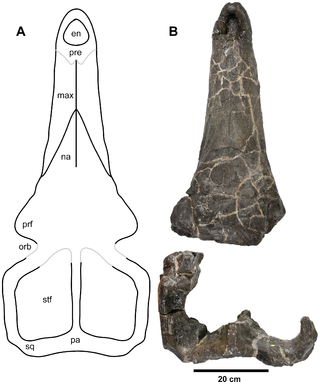
Plesiosuchus is an extinct genus of geosaurine metriorhynchid crocodyliform known from the Late Jurassic of Dorset, England and possibly also Spain. It contains a single species, Plesiosuchus manselii.

Rhacheosaurus is an extinct genus of marine crocodyliform belonging to the family Metriorhynchidae. The genus was established by Christian Erich Hermann von Meyer in 1831 for skeletal remains from the Tithonian of Germany. It was a relatively small reptile, measuring between 1.39 and 1.57 m long.

Suchodus is an extinct genus of marine crocodyliform from the Middle to Late Jurassic period of England and France. It measured between 3.3 and 4.7 m in total body length.
Cricosaurus is an extinct genus of marine crocodyliforms of the Late Jurassic. belonging to the family Metriorhynchidae. The genus was established by Johann Andreas Wagner in 1858 for three skulls from the Tithonian of Germany. The name Cricosaurus means "Ring lizard", and is derived from the Greek Krikos- ("ring") and σαῦρος -sauros ("lizard"). It was a relatively small reptile, with C. suevicus and C. araucanensis measuring 2 m (6.6 ft) and 3.2 m (10 ft) in total body length, respectively.

Steneosaurus is a dubious genus of teleosaurid crocodyliform from the Middle or Late Jurassic of France. The genus has been used as a wastebasket taxon for thalattosuchian fossils for over two centuries, and almost all known historical species of teleosauroid have been included within it at one point. The genus has remained a wastebasket, with numerous species still included under the label ‘Steneosaurus’, many of which are unrelated to each other.

Gracilineustes is an extinct genus of marine crocodyliform that lived in the oceans during the Middle to Late Jurassic. Gracilineustes was a carnivore that spent much, if not all, its life out at sea. It was a small reptile, with G. leedsi measuring 2.25–3.11 m (7.4–10.2 ft) long and G. acutus measuring 3.77 m (12.4 ft) long.

Torvoneustes is an extinct genus of metriorhynchid thalattosuchian. It is known from skull and postcranial remains found in the Kimmeridge Clay Formation of Dorset and Wiltshire, England, the Virgula Marls of Switzerland and also from Oaxaca, Mexico . The holotype skull of the type species was initially assigned to the species Metriorhynchus superciliosus. Postcranial remains were later discovered from the same quarry as the skull, and then these specimens were recognised as belonging to a new species of Dakosaurus, as D. carpenteri. The species was named to honour Simon Carpenter, an amateur geologist from Frome in Somerset, who discovered the fossils.

Macrospondylus is an extinct genus of machimosaurid teleosauroid crocodyliform from the Early Jurassic (Toarcian) of Europe. Fossils are known from the Posidonia Shale of Germany, the Whitby Mudstone of the United Kingdom, and the "schistes bitumineux" of Luxembourg.
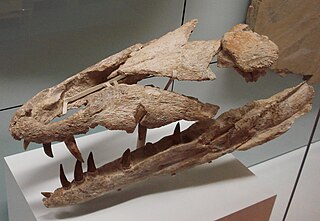
Geosaurinae is a subfamily of metriorhynchid crocodyliforms from the Middle Jurassic to the Early Cretaceous of Europe, North America and South America. Named by Richard Lydekker, in 1889, it contains the metriorhynchids Suchodus, Purranisaurus, Neptunidraco, Tyrannoneustes, Torvoneustes, Dakosaurus, Geosaurus and Plesiosuchus. The last four taxa form a tribe within Geosaurinae, the Geosaurini. Geosaurinae is one of two subfamilies of Metriorhynchidae, the other being Metriorhynchinae.

Thalattosuchus is an extinct genus of marine crocodyliform that lived in the oceans during the Middle to Late Jurassic. Thalattosuchus was named in 2020. Thalattosuchus was a carnivore that spent much, if not all, its life out at sea. No Thalattosuchus eggs or nests have been discovered, so little is known of the reptile's life cycle, unlike other large marine reptiles of the Mesozoic, such as plesiosaurs or ichthyosaurs which are known to have given birth to live young out at sea. Where Thalattosuchus mated, whether on land or at sea, is currently unknown. The name Thalattosuchus means "sea crocodile".
